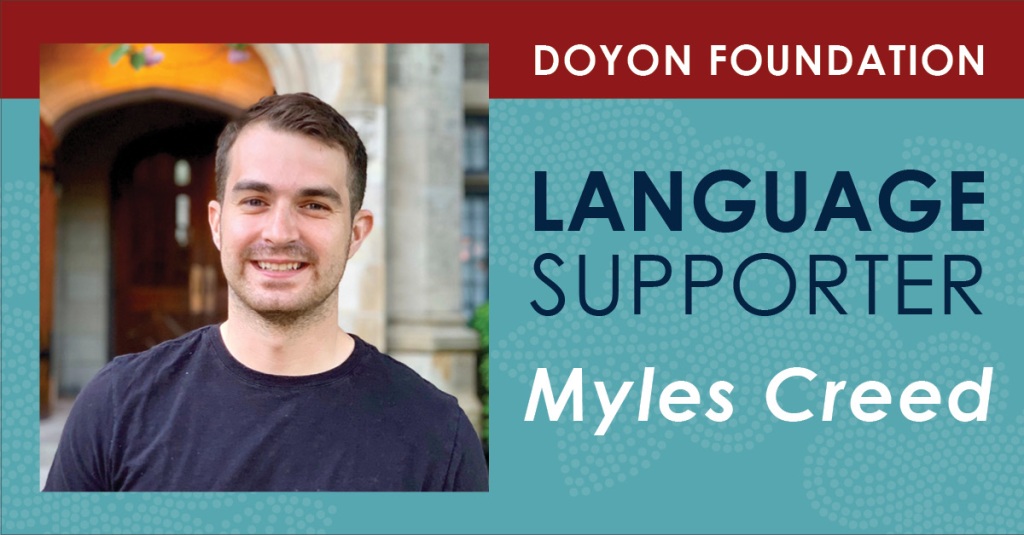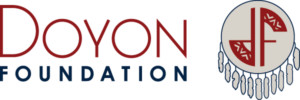
“As visitors on Native land, it’s important that we do the work to support language revitalization.”
– Myles Creed
Myles Creed is a project assistant with Doyon Languages Online, the Doyon Foundation initiative to develop free online language-learning courses for nine Alaska Native languages in the Doyon region. Born in Fairbanks and raised in Kotzebue, Myles is a doctoral student in linguistics who was first exposed to the Iñupiaq language in elementary school, where his teachers included the late Tatqaviñ Ruthie Sampson and the late Qutan Goodwin.
Myles ancestry is English, Irish and French. He is the son of John Creed and Susan Andrews, originally of Massachusetts and former faculty members at the Chukchi campus of the University of Alaska Fairbanks in Kotzebue. Working in support of Iñupiaq language revitalization, Myles led a Facebook Translations project that since 2020 permits anyone the ability to use Facebook in Iñupiaq.
Myles is a founding member of Ilisaqativut, a grassroots collective of Iñupiaq second-language learners and partners. At Doyon Languages Online, his efforts include working with language teams and technology partners to develop Doyon Foundation’s online language courses.
Doyon Foundation: You applied to Doyon Foundation based on your prior work as a supporter of Alaska Native languages – work that helped introduced you to Allan Hayton, the Foundation’s language revitalization program director.
MC: I’ve been a fan of Doyon Languages Online for many years and was excited at the opportunity to join the team, especially knowing that Iñupiaq is one of the Doyon region languages. My work at Doyon Foundation involves getting courses ready to publish online, including video editing, subtitling, working with speakers and language team members, and working with Doyon Languages Online tech partners.
Nine different Doyon region language courses will soon be available online (five are already available – register here!). It’s a great thing that Doyon shareholders and others can use these resources no matter where they are and no matter what language ability they have.
DF: Between your work with Doyon Languages Online, your doctoral work at the University of Victoria, the Facebook project, growing-up in Kotzebue and education at Mount Edgecumbe … how do these experiences position you when it comes to Alaska Native language learning?
MC: I would describe my work as trying my best to be a language supporter and partner. Doing work with Indigenous languages as a non-Indigenous person is not always easy, but it’s important that as visitors on Native land we actually do the hard work to support language revitalization. This includes asking school districts to support immersion schools, supporting Indigenous language legislation, learning important words and phrases, supporting bilingual signage, and educating yourself about Indigenous languages, cultures and worldviews.
I am thankful every day to live on Native lands in Alaska. I think as non-Native people it’s especially important for us to show support for language and cultural revitalization in real, tangible ways that will help reverse the negative effects brought on because of colonization. We have enormous privileges to be able to use English or other foreign languages on Native land; we need to make sure to not continue practices or attitudes that impede the ability for Alaska Native languages to thrive.
DF: How did your growing-up years in Kotzebue shape your interest in Iñupiaq?
MC: We started having Iñupiaq classes in early elementary school. My teachers included the late Tatqaviñ Ruthie Sampson and the late Qutan Goodwin. Ruthie worked with my parents for many years and was gracious enough to give me my Iñupiaq name, and Qutan was well known by everyone for her passion for teaching. They are sincerely missed in Kotzebue and all around Iñupiat Nunaat.
I remember being disappointed when middle school didn’t offer Iñupiaq classes. I was an adult before I really realized how wrong it was that we continued to have daily English classes throughout high school while Iñupiaq was seen as peripheral on Iñupiaq lands. I owe a lot to my childhood in Kotzebue, where everyone knows you and the feeling of community is strong.
DF: Congratulations on completing the Facebook Translations project. By choosing “Iñupiatun” in Facebook’s language settings, it’s now possible to use Facebook nearly completely in Iñupiaq.
MC: Thank you. Yes, it was a big undertaking. I especially want to thank the translators I worked with, Qutuk Muriel Hopson and Pausauraq Harcharek, as well as the other team members, Reid Magdanz, Grant Magdanz and Cordelia Qiġñaaq Kellie. There were many volunteer translators as well who helped.
The Facebook project was meaningful because it’s really important to see language equity online. If people don’t see their own languages represented in places where they spend much of their time, we are not living in an equitable society. Our future will certainly be more and more virtual. It’s important that these virtual spaces are accessible for all languages and backgrounds.
For my dissertation, I’m researching how linguists can rethink what are called “grammars” in the linguistics field. I believe that describing “grammars” purely in the traditional Western academic way has not been helpful for language revitalization. There needs to be a more holistic and collaborative approach to grammar writing going into the future.
DF: Explain a little about learning an Alaska Native language – Iñupiaq, for example. What might a student who’s just getting started need to know?
MC: Learning Iñupiaq is much different than learning a European language. One word in Iñupiaq is often equivalent to a full sentence in English. For example, “Tauqsiġñiaġviŋmuguktuŋa,” one wordin Iñupiaq, translates to the English sentence “I want to go to the store.” And Iñupiaq has a very complex demonstrative pronoun system based on needs for hunting and navigation. Learning Iñupiaq really has to be contextual and land based.
DF: Language learners tell us that the wisdom and humor embedded in Alaska Native languages are real motivators. What else might help along the way?
MC: Language learning is not always easy and can often be frustrating or challenging, but it can also be a lot of fun. Try to find a community of friends and family who are interested in the same things as you, people whom you can lean on and pass the time with. The anxiety of language learning becomes lessened when you are around people you love and can laugh an exorbitant amount with.
About Doyon Languages Online
Through the Doyon Language Online project, Doyon Foundation is developing introductory online lessons for Benhti Kokhut’ana Kenaga’ (Lower Tanana), Deg Xinag, Denaakk’e (Koyukon), Dihthaad Xt’een Iin Aanděeg’ (Tanacross), Dinak’i (Upper Kuskokwim), Dinjii Zhuh K’yaa (Gwich’in), Hän, Holikachuk and Nee’aanèegn’ (Upper Tanana).
The project officially launched in summer 2019 with the first courses, now available for free to all interested learners.
Doyon Languages Online is funded by a three-year grant from the Administration for Native Americans (ANA), awarded in 2016, and an additional three-year grant from the Alaska Native Education Program (ANEP), awarded in 2017.
